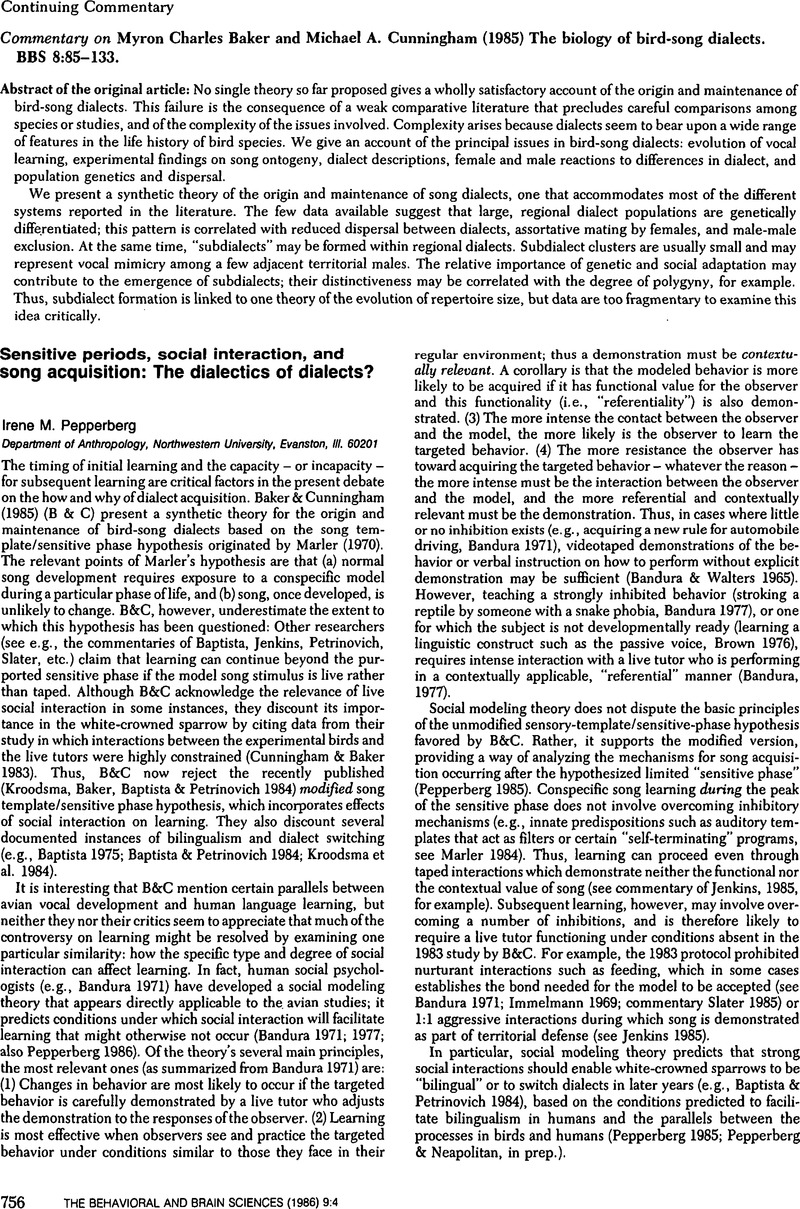No CrossRef data available.
Article contents
Song learning and dialect: More experiments needed
Published online by Cambridge University Press: 04 February 2010
Abstract
An abstract is not available for this content so a preview has been provided. Please use the Get access link above for information on how to access this content.

- Type
- Author's Response
- Information
- Copyright
- Copyright © Cambridge University Press 1986
References
Baker, M. C. & Cunningham, M. A. (1985) The biology of bird-song dialects. Behavioral and Brain Sciences 8:85–100. [rMCB, IMP]CrossRefGoogle Scholar
Baker, M. C. & Cunningham, M. A. (1985r) Comparative dialectology. Behavioral and Brain Sciences 8:119–33. [rMCB]CrossRefGoogle Scholar
Bandura, A. (1971) Psychotherapy based upon modeling principles. In: Handbook of psychotherapy and behavior change: An empirical analysis, ed. Bergin, A. E. & Garfield, S. L.. Wiley. [rMCB, IMP]Google Scholar
Bandura, A. & Walters, R. H. (1965) Social learning and personality development. Holt, Rinehart & Wintson. [IMP]Google Scholar
Baptista, L. F. (1975) Song dialects and demes in sedentary populations of the white-crowned sparrow (Zontrichia leucophrys nuttalli). University of California Publications in Zoology 105:1–52. [rMCB, IMP]Google Scholar
Baptista, L. F. (1985) Bird-song dialects: Social adaption or assertive mating? Behavioral and Brain Sciences 8:100–101. [IMP]CrossRefGoogle Scholar
Baptista, L. F. & Morton, M. L. (1982) Song dialects and mate selection in montane white-crowned sparrows. Auk 99:537–47. [IMP]Google Scholar
Baptista, L. F. & Petrinovich, L. (1984) Social interaction, sensitive phases and the song template hypothesis in the white-crowned sparrow. Animal Behavior 32:172–81. [IMP]CrossRefGoogle Scholar
Brown, I. (1976) Role of referent concreteness in the acquisition of passive sentence comprehension through abstract modeling. Journal of Experimental Child Psychology 22:185–99. [IMP]CrossRefGoogle Scholar
Cunningham, M. A. (1985) Vocal learning in Nuttall's white-crowned sparrow: Deceptive mimicry or genetic identity? Ph.D. Dissertation, Colorado State University. [rMCB]Google Scholar
Cunningham, M. A. & Baker, M. C. (1983) Vocal learning in white-crowned sparrows: Sensitive phase and song dialects. Behavioral Ecology and Sociobiology 13:259–69. [rMCB, IMP]CrossRefGoogle Scholar
Immelmami, K. (1969) Song development in the zebra finch and other estrildid finches. In: Bird vocalizations, ed. Hinde, R. A.. Cambridge University Press. [IMP]Google Scholar
Jenkins, P. F. (1985) Song learning, competition, and dialects. Behavioral and Brain Sciences 8:108. [IMP]CrossRefGoogle Scholar
Kroodsma, D. E., Baker, M. C., Baptista, L. F. & Petrinovich, L. (1984) Vocal “dialects” in Nuttall's white-crowned sparrow. Current Ornithology 2:103–33. [IMP]Google Scholar
Lenneberg, E. H. (1973) Biological aspects of language. In: Communication, language, and meaning, ed. Miller, G. A.. Basic Books. [IMP]Google Scholar
Marler, P. (1970) A comparative approach to vocal learning: Song development in white-crowned sparrows. Journal of Comparative and Physiological Psychology 71:1–25. [IMP]CrossRefGoogle Scholar
Marler, P. (1984) Song learning: Innate species differences in the learning process. In: The biology of learning, ed. Marler, P. & Terrace, H. S.. Springer-Verlag. [IMP]CrossRefGoogle Scholar
Pepperberg, I. M. (1985) Social modeling theory: A possible framework for understanding avian vocal learning. Auk 102:854–64. [rMCB, IMP]Google Scholar
Pepperberg, I. M. (1986) Acquisition for anomalous communicatory systems: Implications for studies on interspecies communication. In: Dolphin behavior and cognition: Comparative ethological aspects, ed. Buhr, R., Schusterman, R., Thomas, J. & Wood, F. G.. Erlbaum. [IMP]Google Scholar
Petrinovich, L. (1985) An unbalanced survey of bird-song research: Smoke gets in your eyes. Behavioral and Brain Sciences 8:113–14. [IMP]CrossRefGoogle Scholar
Slater, F. J. B. (1985) White rats and general theories. Behavioral and Brain Sciences 8:115–16. [IMP]CrossRefGoogle Scholar
Snow, C. E. & Hoefnagle-Höhle, M. (1978) The critical period for language acquisition: Evidence from second language learning. Child Development 49:1114–28. [IMP]CrossRefGoogle Scholar
Snow, C. E., Arlman-Rupp, A., Massing, Y., Jobse, J., Joosten, J. & Vorster, J. (1976) Mothers' speech in three social classes. Journal of Psycholinguistic Research 5:1–20. [IMP]CrossRefGoogle Scholar




